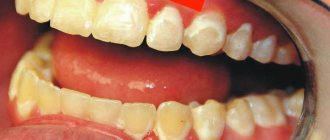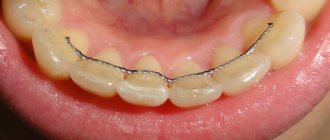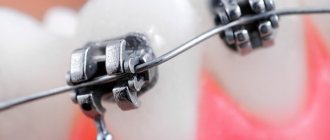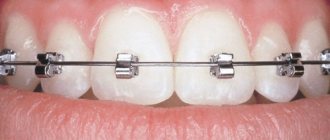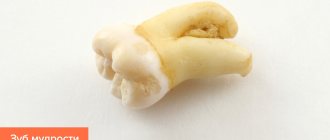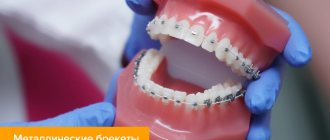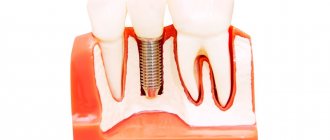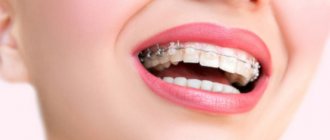This is a headache and a nightmare for any orthodontist: a patient who has had his braces removed and given a removable retainer and instructions for its use returns after some time with complaints about the curvature of his previously straight teeth. The retention period is the most psychologically difficult part of the treatment. Everything is already perfect, and then you have to wear a retainer. Yes, there are other reasons for the unsuccessful outcome of the correction. And although they are much less common, let’s talk about them in more detail.
The process of tooth movement
The fact that teeth have returned to their original position after wearing braces, unfortunately, occurs in many patients. Let’s look at the reasons for this problem and find out how teeth behave during the treatment process.
Braces aim to straighten teeth by applying a certain amount of pressure to them. This moves the tooth in the desired direction. However, a tooth is just one unit of a rather complex jaw system. Its root is located in the jaw bone, surrounded by bone tissue. In this case, the root and bone tissue have a certain space between them - the periodontal gap. It contains nerves, blood vessels and ligaments to nourish and hold the tooth.
When a tooth moves, under the influence of the leveling system, the bone tissue liquefies. In such a situation, nerves and blood vessels are forced to rebuild. The place where the tooth was originally located is vacated and is overgrown with bone tissue. Throughout the treatment, the ligaments holding the tooth are stretched. But they are very elastic, and when the teeth are freed from braces, they tend to their original shape. And the new bone tissue that appears in the place vacated by the tooth is still quite weak, because to fully strengthen it, it takes from several months to several years, depending on the characteristics of the patient’s body. For this reason, teeth may move apart.
A patient whose braces have been removed is prescribed by a doctor to wear retainers. Which are put on the inside of the dentition for a period determined by the doctor. This is how the result achieved with braces is secured.
Removable products
Using mouthguards after braces for the first time means wearing them constantly and removing them only during meals. Then you can put on the mouthguards only at night. If a positive result of fixing the position of the teeth is already visible, the orthodontist may prescribe their use every other day.
The aligners may be clear or have a tint resembling enamel. The products are put on one jaw or two at once, depending on the type of mouthguard. You can also insert metal wire into them, which will increase the rigidity effect and prevent deformation.
Caring for the mouth guards is quite simple. They are treated with paste and rinsed with running water. The advantages of these products:
- convenient to use;
- easy to clean;
- the ability to remove them if necessary.
Minuses:
- products are noticeable on the teeth;
- may cause speech impairment;
- cause a lot of salivation.
Some patients are unable to wear mouth guards due to an allergy to the plastic or irritation.
Why do teeth return to their previous position?
The return of teeth to their original position can be observed for several reasons. If the patient refuses to wear retainers or use these devices contrary to the current rules. This violation occurs in removable structures. It is recommended to remove them only during meals and when performing hygiene measures. Gradually, the patient will wear retainers less and less often, up to several hours a day, and subsequently abandon them completely.
People who neglect the advice of specialists, as a rule, these are children, experience difficulties in the future, and in especially serious cases, their braces are re-installed. It is also important to remember that the slightest cracks, deformations or breakages of braces, and subsequently retainers, can lead to complications in the form of a lack of results in correcting the bite.
The second reason, also quite common, is the incompetence and low qualifications of the orthodontist. In this case, you should immediately protect yourself and your child by contacting an experienced specialist and a good clinic. It is important that the specialist knows how to use special equipment and has experience in installing braces. It is also important that the devices that will be installed on the patient’s teeth must be of the highest quality. This can be an additional guarantee of good quality of future structures, and will allow you to quickly correct the patient’s bite or other anomalies.
Fixed products
Fixed retainers are a fairly rigid wire that is secured with a special glue to the back of the teeth. The installation can only be performed by an orthodontist.
Such structures can be installed before removing the bracket system, or immediately after it. Before the procedure, it is important to prepare the oral cavity and clean it from plaque and tartar.
It doesn't take long to get used to such retainers. This will take a maximum of a week. And their main advantage is that they are invisible to others.
Other advantages of the products:
- they cannot be lost;
- act on the teeth continuously;
- do not cause discomfort.
Negative points:
- difficulty of oral hygiene;
- the need for constant visits to the doctor;
- there is a risk of peeling off.
There are cases when different retainers are used in combination. For example, fixed ones are for the upper jaw, and removable ones are for the lower jaw.
How to properly care for devices
Removable items should be washed regularly with warm running water and cleaned with a toothbrush and toothpaste. Once or twice a week they need to be soaked in a special solution. To prepare it, you need to dissolve a tablet for dentures in a given volume of liquid and place the device in the resulting composition. Then rinse it with water.
If permanent retainers are installed after braces, then teeth are brushed as usual. Additionally, you should use irrigators, special brushes, and floss. These devices allow you to avoid the rapid deposition of plaque and stone. Toothpicks should not be used to remove food debris from under a metal wire - this will cause it to peel off.
What to do if your teeth become crooked after braces are removed?
Retainers help prevent teeth from becoming crooked after braces are completed. Thin metal wire does not allow teeth to change their acquired appearance, securing the result of treatment.
The use of aligners is also a method to return teeth to their place. If serious complications occur, you may have to reinstall the braces system. Therefore, a patient who notices tooth displacement after braces should contact his doctor as soon as possible, so the correction will be easier and more effective. Teeth shifting is quite normal, and if retainers or mouth guards are not used after removal, this is likely to occur. There are cases when a retainer was immediately installed, but the teeth still moved apart. This means that the design does not work due to its incorrect installation.
Most often, all the blame for the fact that the teeth have moved apart lies on the shoulders of the patient, who, having received a perfect smile and tired of braces, stopped paying due attention to the oral cavity and did not follow the doctor’s recommendations.
After removing the braces, the doctor examines the results obtained and recommends one or another method of correction.
Have your teeth moved apart after braces? Use retainers
Retainers help keep teeth in the desired position after using braces, but using them alone is not enough. It is also important to adhere to the following recommendations:
- Do not reduce the wearing time of the leveling structure. How long you need to wear retainers depends on the patient's age, personal habits and genetic predisposition.
- When using removable structures, they must be removed on time (during eating and bathing) and thoroughly cleaned.
- Fixed retainers require cleaning with orthodontic floss in addition to a regular brush.
- You should rinse your mouth with a liquid containing fluoride every day.
- You should visit the orthodontist at least twice a year.
The retention period can be extended upon the recommendation of a doctor. Afterwards, the patient often wears soft mouth guards. Gradually they are worn less and less.
Retention devices and structures
Removable retainers. These are metal plates with arches that are installed so as to maintain the correct position of the teeth, limit their movement, and secure them in the position that was achieved during correction. They are installed on the inside of the dentition, they are invisible, and are almost not felt by the patient.
Removable retention guards. They are made from biopolymer materials based on a dental impression. They look like transparent overlays, the patient can take them off and put them on. They accurately follow the correct shape of the dentition and hold the teeth in the optimal position, preventing them from moving.
In the first phase of the retention period, removable retention devices are used almost continuously: the patient must wear them 22 hours a day, removing them only during meals. Gradually, as the dental system stabilizes, the time of using mouth guards or retainers is reduced. The period of wearing them can be shortened only on the recommendation of the treating orthodontist.
Fixed retainers. The structures are installed on the inner surface of the crowns and secured with dental glue. These are plates with arches that support the dentition in the correct position. Installation of a fixed retainer is most often performed on incisors and canines. Less commonly, such structures additionally support premolars. A permanent retainer can be used in conjunction with retention aligners. The patient wears such a device constantly without removing it. It is invisible to others and not felt in the mouth. It is believed that with fixed structures, the retention period is more comfortable, and the results of orthodontic treatment stabilize faster.
Cast splinting retainers. Used during the retention period for patients who have malocclusion combined with periodontal diseases. The design is non-removable, rigidly fixes the crowns and limits their mobility, helping to correct the condition of periodontal tissues.
Do you have questions about retainers and mouth guards?
We will call you back within 30 seconds
+7
How long to wear retainers?
How long the retention period will be largely depends on how crooked the teeth were initially. For example, open, deep, cross and distal bites need to be treated for quite a long time, and a long fixation period is also required.
The patient's age also plays an important role. The younger the patient, the more pliable his jaws are, and the shorter the treatment period.
There are patients whose bite treatment does not give a stable result. And he has to wear retainers all the time. In such a situation, it is better to install a non-removable product, since constantly removing and putting on mouth guards will require too much patience.
The patient must go to the doctor throughout the entire retention period. The frequency of visits is individual in each case. But not every six months. The specialist must monitor the correction process and make any adjustments if necessary.
If the patient does not pay proper attention to the care of the oral cavity and retainers, the structure may break or the formation of inflammation due to plaque or tartar. In this case, there is a need for an unscheduled visit to a specialist.
How long the retention period will last for a particular patient depends on the complexity of the situation. Typically, this period is equal to twice the period of use of braces. That is, if the patient wore braces for a year, he will use retainers for another 2 years.
Duration of rehabilitation
The duration of the retention period is primarily determined by the severity of the initial dental defect. Correction of an open, deep, distal or crossbite involves not only lengthy treatment, but also a long recovery period.
In addition, the duration of recording the result depends on the age of the patient. In children, bite correction occurs much faster than in adults, since their jaw has not yet formed.
It is worth noting that not all people have the opportunity to correct a dental defect. Therefore, due to the anatomical features of the jaws, patients will have to wear retainers throughout their lives. In this case, experts usually recommend using a removable product.
A specialist can increase the retention period if there was no proper care of the structure and the oral cavity, or if for some reason there was a breakdown or separation of the permanent product from the enamel.
The duration of the retention period is determined individually for each patient. During a consultative examination, a specialist can only guess the approximate lifespan of the device. On average, you have to wear retainers twice as long as braces.
Preventing crooked teeth after braces
Wearing braces for a long time can be in vain if the results are not fixed in time. After all, the dental organs can return to their previous position. For this purpose, retainers are used in orthodontics to secure the results after braces.
Advantages of retainers:
- Quickly and easily attach to teeth.
- They have a compact size.
- Effectively influence the dentition, keeping teeth in the correct position.
- They are not visible to others, as they are located on the inside of the teeth.
- Guaranteed positive results when used correctly.
Causes of tooth displacement
After orthodontic treatment is completed, teeth tend to return to their original position. The most common causes of dentition displacement are:
- patient's refusal to wear retainers,
- non-compliance with the rules of operation of the splinting structure,
- deformation or other damage to the retention system, as a result of which it loses its functions.
Another risk factor is the incorrect selection of a retention device. An experienced doctor should choose a design taking into account the structural features of the patient’s dental system. If this is not done, the retainer will not be able to cope with the high load, which will worsen the treatment result and will most likely lead to relapse.
What types of retainers are there?
A retainer is a special wire attached to the back of the teeth. They are usually fixed in place of the fangs. With their help, teeth do not move apart after braces. The patient hardly feels this product in his mouth.
Varieties of such structures:
- Removable products. They can be single-jawed (used at any time of the day) or double-jawed (worn at night).
- Non-removable products. They are fixed to the inside of the teeth with a special adhesive. After getting used to it (about a week), they do not cause discomfort at all.
The orthodontist will recommend and tell the patient which design to choose, how to wear it and how to care for it.
Types of Dental Retainers
Thanks to technological progress, today the buyer can choose the type and color of the device that fixes the result. At the same time, in some cases, the doctor may insist on using a more rigid type of construction.
Today, there are two types of retainers, which differ significantly in both the installation method and the wearing process. We list the features of each type:
- Removable . These include mouthguards, which are based on medical plastic. They can be used both on two jaws at once, and on any one. There are clear mouthguards that are more suitable for adults to wear during business communication, and colored ones designed for children and teenagers, helping them highlight their individual style. Also classified as removable are the so-called night guards, which are used at the final stage of treatment.
- Fixed . Static retainers are similar to braces. They are installed for “unreliable” patients so that the course of treatment prescribed by the doctor is not interrupted and is as effective as possible. The design of the devices includes a spring that is attached with glue to the molars and holds the dental rows from moving.
Rules for wearing retainers
To prevent your teeth from becoming crooked again after the braces are removed, it is important to follow your doctor’s recommendations regarding retainers.
You must adhere to the following rules:
- The doctor determines how long the structure should be worn; the patient should not reduce the period of use.
- Doctors recommend using dental floss during the retention period, since it becomes almost impossible to clean some areas of the oral cavity without it.
- It is important to clean removable mouth guards thoroughly and remove them when eating.
- It is recommended to rinse your mouth with fluoride-containing liquid.
- It is important to have your teeth professionally cleaned at a dental clinic, at least once every six months.
The doctor observes the changes that occur during the retention period and, at the end of it, may prescribe products of less rigidity - plastic mouth guards. They are initially worn only during sleep, then used every other day, gradually reducing the number of wearings to once a week.
Hygiene with braces
A person with braces takes about 10 minutes to brush their teeth in the morning and evening. In addition, you will have to clean and rinse your mouth several times during the day - after each meal. To do this, you need to use special hygiene products. Among them:
- An orthodontic brush with a depression in the center of the bristles (V-shaped), such as CURAPROX Ortho. Thanks to this shape of the bristles, it cleans well not only the teeth, but also the structure itself. You should spend at least 3-4 minutes cleaning with this brush in the morning and evening.
- Mono-beam brush (Curaden International CURAPROX 1006 Single & Sulcular, Cumdente Gmbh CURAPROX 1006 Single & Sulcular). It can be used to clean each tooth individually. This brush is especially convenient for cleaning molars and numbers of eights. It is used after standard cleaning.
- A brush is an orthodontic device made of wire and bristles, the length of which decreases from base to tip (Curaprox CPS 10, Biorepair Scovolini Interdentali Cilindrici). Using a brush, the space between the arch and the teeth is cleaned, as well as around the brace locks. The brush should be used after every meal.
- Dental floss with hard fibers (Mirafloss implant chx). It helps clean the interdental spaces. It should be used at least once a day, especially after eating fibrous foods such as meat.
- Rinse aid (Biorepair Mouthwash). You will need it immediately after eating for cleansing and disinfection. It is advisable to purchase products that contain calcium.
- An irrigator is a device that allows you to efficiently clean the interdental spaces from food debris and germs, as well as remove plaque. It must be used at least 2-3 times a week. For people who often travel, a portable irrigator (Panasonic EW-1411) is suitable, and for home use you can buy a stationary device (Donfeel OR-820D Compact). Choose models with attachments for orthodontic structures.
It is better to buy all these products after consulting a doctor. Do not forget about the preventive examinations that the orthodontist will prescribe. At the first symptoms of caries and other pathologies, consult a doctor without waiting for a routine examination.
Correction principle
The jaw system, as one of the parts of the human body, has certain patterns. And attempts to make changes to it quite justifiably cause resistance from the body.
The roots of the teeth are located in the bone tissue of the jaw. The vessels of the periodontal fissure supply nutrients, and ligaments and nerve fibers fix the tooth in a certain position.
Braces change the structure of teeth and their roots. The bone tissue is resorbed, and the blood vessels are rebuilt. The ligaments are stretched. This creates a cavity, which gradually begins to fill with bone tissue.
Stretched ligaments after removing braces, like an elastic band, try to take their previous position, and the growing, not yet strong enough bone tissue further contributes to the occurrence of such a relapse as the return of teeth to their original place.
In order for the bone tissue to be completely fixed, it takes different times in different cases, at least several months. For this reason, orthodontists recommend their patients to use retainers to consolidate the achieved results.
Prevention
Let's look at the recommendations that need to be followed to avoid loosening of teeth after removing braces.
When using removable aligners:
- the product must be worn constantly for the first six months;
- then the mouthguards are worn at night for another year;
- After another year and a half, you can wear them every other night.
When using permanent retainers:
- it is important to check twice a month how well the structure is secured;
- structures must be used and cleaned correctly.

